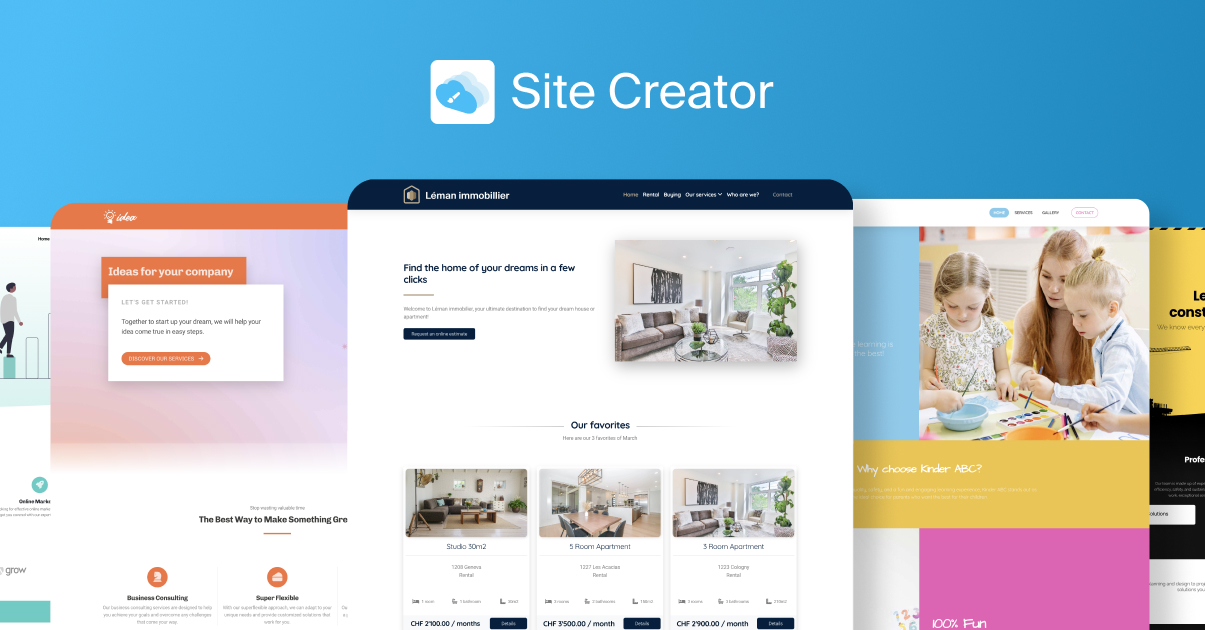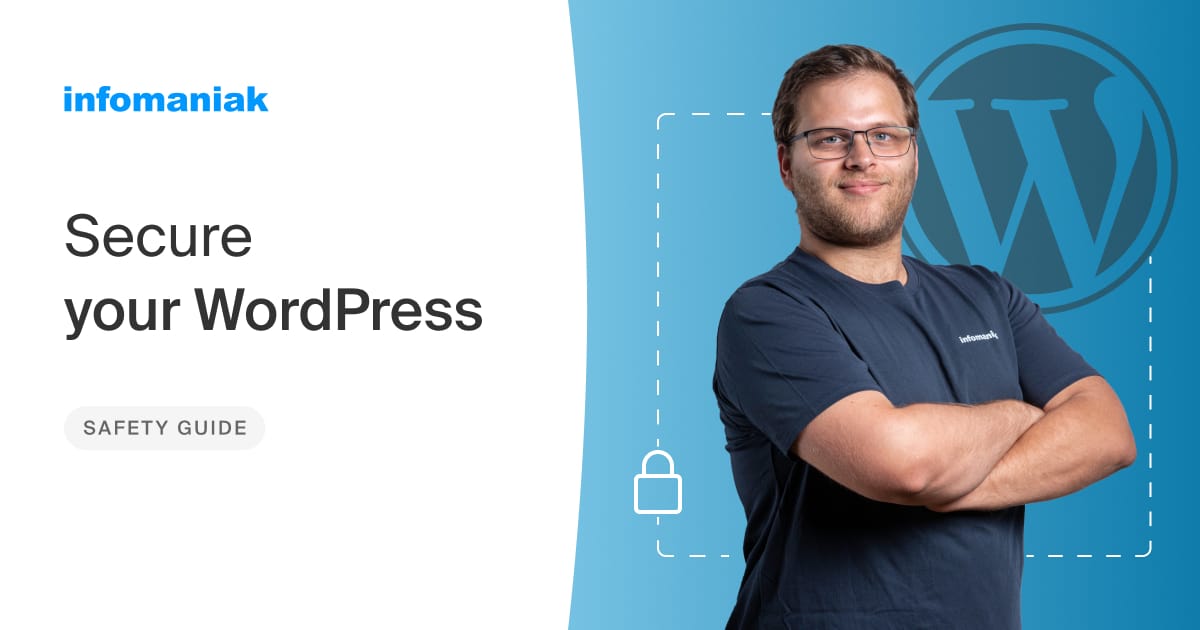Which page builder for WordPress? This article summarises everything you need to know in order to choose the best page builder for your WordPress site, prioritising long-term reliability. We also answer the most frequently asked questions with regard to page builders in order to help you move to the next phase: create your WordPress website!
Our top 3 page builders for WordPress
Let’s get one thing straight right away: each page builder has their own particularities, and you should make your choice according to your project or your way of working. Here are the page builders we will take a closer look at together:
- Elementor
- DIVI builder
- Thrive Architect
So what is a page builder?
When you decide to create a WordPress website, choosing a hosting solution and a theme are often the first questions that come to mind. But if you are looking for a page builder, it means that you want to personalise your website even more. A page builder allows you to really personalise the structure of your pages deep down, and the process of choosing your page builder should not be taken lightly because once you get started, it is very difficult to change creation tools.
1. A page builder fills in the gaps in your theme
It should be recalled that a WordPress theme serves to alter the general appearance of your website. It only defines the graphical formatting of the common elements which will not change between the different pages of your website, such as:
- the typography
- the logo
- the menu
- the header
- the footer
- the general format
- the selection of widgets
In the blog section of your website, the theme formats the list of articles (the format of the title, the category, the date of publication and the author) and the section after the articles (in particular the comments). The page builder manages the content of the articles and pages.
2. It allows you to create tailor-made pages
The page builder is installed as an extension which replaces the native editing system on WordPress, which is currently Gutenberg (June 2022). The mechanics are simple – pre-built content blocks allowing page mock-ups to be created. These mock-ups can then be transformed into templates to be used subsequently for an unlimited number of other pages or projects. For developers, a page builder accelerates the creation work by reproducing templates or providing ready-to-use functions. For beginners, it allows them to create rich page structures without requiring any coding skills.
Before choosing your page builder for WordPress, you must check 4 points
Just before we take a close look at the details, here are the 4 prerequisites which determined our selection:
- Freedom of choice
Your page builder must give you the technical freedom to choose the theme. - Extended capacities
It must cover all your needs, preferably without requiring additional third-party plug-ins. - Project vitality
The project must benefit from sustained development (security) and an active community. - Recognition by the users
The editing mechanics must be intuitive and approved by the users.
Elementor: an excellent starting point that is free of charge for most projects
Elementor is the most popular page builder on WordPress. It offers the largest marketplace linked to a page builder, with a very large number of third-party editors complementing its basic functions. Its pay-for version, Elementor Pro, is also a theme builder and offers more specialised modules (widgets) such as price tables, portfolios, slides, share buttons dedicated to social media, etc. For marketers, the pay-for version also makes it possible to create your own pop-ups, with triggers such as scroll depth or the time spent on a page.
Publishing mechanics of Elementor
The mechanics of Elementor is based on drag and drop, and the interface is highly intuitive: on the left, the side panel with the content blocks and on the right, the real-time preview of the site that you can modify at will. Simply drag and drop the pre-built blocks to build an attractive page adapted to mobile phones. The Pro version offers almost unlimited personalisation possibilities. As it offers significantly more blocks and options, it is necessary to take ownership of the version.
The development of Elementor
Elementor is by far the leading page builder, with a total of 7 million active installation. Elementor is also entirely compatible with WooCommerce if you need to create an online shop.
The simple interface makes it a favourite with agencies, which can create limited access for their customers and enable them to manage their site easily.
There is a huge volume of online documentation, with numerous tutorials and training courses on YouTube. The community is also highly active on the forums and Facebook groups. It is therefore easy to obtain assistance if required.
Best themes for Elementor
To simplify your decision, we advise you to start with the Hello Elementor or OceanWP theme, event if Elementor is also compatible with numerous other themes (in particular WP Astra). Both are excellent themes that are optimised for Elementor. By combining the free functions of OceanWP with the free version of Elementor, you will already obtain a wide variety of functions. You can always take the pay-for options once you have tested the free options.
The templates supplied with Elementor
More than 100 professional website kits are available with the pay-for version. This is fewer than DIVI, which we will examine later, but you also have access to templates of themes and pop-ups which complement the offer. It is therefore a question of preferences and needs.
The price of Elementor
The basic free version is the first advantage of Elementor and explains why it is so popular. The pay-for version is available in three formats: 1 site at $ 49/year, 25 sites at $ 199/year and 1,000 sites at $ 999/year. A less visible option offers the possibility of activating 3 sites for $ 99/year. All these formats provide access to premium support and pre-built professional website kits. The price of Elementor Pro is quite reasonable, but does not include a life-time licence. It must be renewed every year to benefit from updates, which are essential to guarantee the security of your website.
DIVI builder: the champion of visual editing that is a firm favourite with beginners and agencies
DIVI is everything rolled into one: a theme, a page builder and a theme builder. From showcase sites to e-commerce, it is an excellent all-round tool which is particularly important at Infomaniak, as it is provided free of charge with each web hosting solution.
For creative beginners, it is perhaps the most “satisfying” page builder once you are familiar with its visual editing mechanisms, which foster creativity. DIVI is also intended for professionals, and in particular marketers, with its highly practical A/B testing function to test the performance of a call to action (CTA), a button, etc. DIVI also manages the conditional logic in its forms in order to address more elaborate user scenarios.
Its wide range of editing modes is a genuine strength, but it can also confuse users looking for a simpler, more linear treatment. In any case, DIVI is suitable for most projects. It offers versioning, with the possibility of returning to previous versions. Its role editor can also be used to configure access to the different functions: an important option in order to ensure simple management of collaboration with different contributors.
The editing mechanics of DIVI builder
The visual editor of Divi makes it possible to build and sculpt your pages on the actual website, without an editing component. The final result can be seen directly in full screen mode and you can even adjust the size of the sections and separators by show of hands. Its interface is scattered with “+” icons to insert content into each block on the fly. Only a floating tool bar at the bottom of the screen can be seen. It makes it possible to switch from one viewing mode to another, such as wireframe/mock-up mode, in order to juggle the numerous blocks (or “modules”) and design elements and build the structure of your pages like a Lego kit.
The development of DIVI builder
DIVI Builder is a confirmed best-seller, with a total of 2.3 million active installations. In June 2022, this represents 16% of WordPress sites in Switzerland and 6% of the top 1 million WordPress sites worldwide (ranking by traffic). It is also fully compatible with Woo Commerce, the reference point when creating an online shop with WordPress.
DIVI is developed by Elegant Themes, which constantly brings out new developments while offering free templates and new modules. DIVI even has its own marketplace which brings together page templates, children’s themes and exclusive extensions. By choosing DIVI, you are guaranteed to be able to find a great deal of online documentation. The community is very active with Facebook groups, YouTube tutorials, video training courses, a regular selection of rich blog articles and support via chat and email.
Best themes for DIVI builder
The previously modest performances of the DIVI theme have improved considerably in recent years. It’s worth installing DIVI to take advantage of the templates offered by the theme. For anyone wanting to do everything from A to Z, DIVI builder can also be used with two other lighter themes which can be loaded quickly : OceanWP and the highly flexible Astra.
The templates supplied with DIVI
To create an attractive website quickly, DIVI offers almost 2000 page templates with more than 250 website kits, for example including a start page, a contact page, a services page, etc. DIVI naturally allows you to save your pages as templates for subsequent use, making it very suitable for agencies. The access licence also provides access to the entire Elegant Theme ecosystem, i.e. 110 other WordPress themes as well as the Monarch, Bloom and Extra plug-ins.
The price of DIVI builder
Infomaniak provides DIVI free of charge with all its web hosting solutions. You can also use all the extensions and all the themes of Elegant Themes. Everything is accessible, but you must take out a licence if you wish to benefit form the Elegant Themes support.
For an unlimited number of website, the annual licence (including premium assistance) costs $ 89 per year and a life-time licence costs $ 249. This unlimited licence is therefore a very good option for freelancers and agencies working on several projects.
Thrive Architect: the marketing toolbox for pages that need to convert
Thrive Architect is the favourite page builder of marketers and infopreneurs. Let’s do away with prejudices straight away: Thrive Architect is not reserved for specialists in the fields of marketing and sales. In fact, it is highly effective for anyone wanting to convey a message to their audience and transform visitors into customers.
You can use it to develop your professional activity or to recruit members for your sports club or association, for example. Thrive Architect is designed to help you create attractive and convincing pages as quickly as possible. It calls on tried-and-tested conversion templates, for example landing pages combined with their confirmation pages in order to generate leads using a form. It also provides opt-in, webinar or sales page templates, etc.
The page builder offers styles to be applied specifically to your blog in order to improve the commitment rate and social media sharing. Thrive Architect promotes optimisation through “smart elements” in order to modify elements across all your pages. It centralises the parameters, for example to change the accentuation colour of your website which will automatically be picked up by your different construction elements or your footer links.
Thrive Architect provides construction modules such as countdowns to encourage people to make a decision, lead generation forms, price tables for comparisons, guarantees for lifting objections, call for action buttons, etc. In short, everything here is designed to promote conversion.
Publishing mechanics of Thrive Architect
Thrive Architect (rightly) to be ultra-effective. Its aim is to enable you to create pages by eliminating obstacles and doing part of the work upstream. That is where the pre-built and pre-formatted elements come into play. Thrive Architect is full of very accomplished content, and not simply empty blocks of blocks filled with Lorem Ipsum. Admittedly, your website won’t write itself, but Thrive Architect lays the foundations! And it is not entirely a joke: in Thrive Architect, the templates contain content modules that are already written. The provisional texts are actually writing advice which you replace with your own text. You are guided in the right direction with advice on what to write and where to write it to have an impact.
With regard to visual editing, the ergonomics of Thrive Architect is relatively similar to Elementor: a pane on the right containing blocks with an editable real-time preview in the right-hand section of the window. The parameters are accessible in a panel on the left. The smart elements accelerate the personalisation of all your pages simultaneously: all you need to do is change your styles in one place and this will be copied across your entire website.
The development of Thrive Architect
Thrive Themes is the successful company behind Thrive Architect. It initially forged a solid reputation among sales/marketing specialist with its themes and plug-ins. Today, the popularity of its services has reached the general professional world in the broadest sense of the word, thanks to an ecosystem of excellently thought-out tools that are highly practical to use. Thrive Architect benefits from a large fan base and continuous development. This gives rise to original functions such as automatic page scrolling and modules including animations to fix the attention of visitors, for example.
The plug-in offers thousands of integrations with Zapier (automation service) and is perfectly adapted to marketing emails. It enables you to connect to almost every email service via API, whereas Elementor and DIVI builder both require an additional plug-in.
Best themes for Thrive Architect
Thrive Architect can be used with a wide range of themes such as OceanWP and WP Astra, which we have already mentioned. If you choose Thrive Theme Builder as an additional element, you can create the general structure of your website in just a few minutes, thanks to an installation utility and Shapeshift, which is a customisable theme including pre-designed sections optimised for conversions.
Thrive Theme Builder includes tools (dynamic content, fast caching, automatic image optimisation, pages in silos, etc.) to accompany the development of your website as it grows. In short, you will have realised that the Thrive Themes ecosystem is ultra-complete and attractive.
The templates supplied with Thrive Architect
More than 350 exclusive landing page templates are ready for customisation. We have already seen that content is a key lever of Thrive Architect. We advise you always to begin with a template in order to benefit from layouts that have already been tested and approved for their conversion capacity.
The price of Thrive Architect
If you want to use Thrive Architect, there are no free lunches. Two options are open to you: the Thrive Architect plug-in licence alone at $ 97/year and the subscription to the full toolbox, Thrive Suite, for $ 299/year. Without wanting to go into the details of the rest of this article, you should know that tools such as Thrive Ultimatum, Thrive Leads and Thrive Theme Builder included in the suite are extremely valuable in order to develop your activity online.
What is the best page builder and for whom?
DIVI, Elementor and Thrive Architect all boast a large number of active installations. They benefit from continuous development and economic templates that have proved their worth over a number of years. These guarantees must not be underestimated as, regardless of your WordPress site project, the page builder will be your long-term work tool. Unless you fiddle around and use plug-ins to clean the code, it will be difficult to change it (in particular due to the use of shortcodes). To limit the damage in the event of change, a good strategy involves using your chosen page builder solely for the pages of your website and prioritising the native WordPress editor (Gutenberg) for your blog articles.
Choose Elementor if
- you are looking for an excellent free page builder
- you will edit the website with users/customers who are beginners
- you want to be able to create a very large number of websites
Elementor is developed to provide the most intuitive experience and its free version is generous. Its editing mode is powerful and its ergonomics ensure you don’t lose you way. We recommend Elementor to all users who need this simplicity, i.e. beginners or agencies who want to create editing accounts for their customers. Elementor Pro guarantees access to numerous widgets and functions that often take developers a long time to recreate. It manages reusable templates and is ideal for accompanying very advanced projects without any difficulty.
Choose DIVI builder if
- you are looking for a page builder focussing on creativity
- you need numerous customisable website templates
- you need the integrated A/B testing function
- you want to create an unlimited number of websites with a life-time licence
DIVI builder is the page builder you should prioritise if you are creative. It is the only tool that boasts so many visual editing modes. Its “mock-up”/wireframe view and its visual editor make it a gem for anyone wanting easy control of every aspect. In other words, we feel that DIVI is more for users who are familiar with WordPress. DIVI meets the expectations of professionals, with the management of reusable page templates, A/B testing, etc.
Choose Thrive Architect if
- your priority is to convert your audience or if you are an infopreneur
- you need specialist modules (credit card options, payment icons, purchase guarantees, content to be revealed, etc.)
- you are willing to invest $ 97/year with very good value for money
- you need over 300 landing page templates tried and tested for sales
- you are interested in the Thrive Suite (Thrive Leads, Thrive Comments, Thrive Automator, etc.)
Thrive Architect is the most specialised page builder in our selection. It has been developed to offer the largest possible lever thanks to a considerable depth of marketing/sales functions, yet remains an excellent tool for all types of project. We recommend Thrive Architect for anyone wanting to focus on development and growth. From this standpoint, Thrive Architect is the best tool for creating your pages. With its integrated writing tips, it can cure writer’s block. This accompaniment is all the more valuable if it is your very first website. This can therefore play a decisive role in the direction you take. The quality can be seen at every level: the quality of the templates, integration with third-party services, specialist functions, integration in a suite of recognised marketing tools, etc.
Our advice when choosing a WordPress page builder
Prepare a mock-up
It is difficult to know what you need if you are not really sure which direction you are taking. We advise you to create a draft, a mock-up of your pages which will contain the different content zones, the desired sections, the illustrations and the text zones that you want to insert. To do this, DIVI proposes the very useful wireframe view, but you can also use third-party software such as Adobe XD or Figma, which offer a free format. This will enable you to find the right structure and to focus on the content without initially needing to pay too much attention to the technical issues. This will enable you to choose the page builder best suited to your project.
Do a trial run
To get a real idea, we advise you to try these page builders yourself before taking a decision. Elementor can be installed free of charge via your WordPress installation like any other plug-in. DIVI comes with its theme, but you can get a preview directly via the live demo. Finally, you can try Thrive Architect for a period of 30 days (not to be exceeded), with a satisfied or refunded guarantee. Numerous videos also offer you the chance to get a clear picture of these page builders on YouTube.
Give Gutenberg a chance for your articles
The blog represents a large part of your website’s capital. Of possible, we advise you to use the native editor (Gutenberg) for your blog articles in order to guarantee the portability of their layout over time. The aim is to avoid the risk of encountering a problem linked to an update or change of editor.
Contact a seasoned professional
Calling on a professional can help you get your project off on the right track, especially if it is your very first experience with WordPress. If you think you need help, we advise you to submit your project on our partner platform, with no binding commitment, in order to receive several free estimates from professionals capable of accompanying you. Whatever the case, try to limit the number of plug-ins you install as far as possible, choose a strong password for your website and update WordPress, your theme and the plug-ins you use on a regular basis.
Your questions about page builders
What is the difference between a page builder and a WordPress theme?
A theme primarily manages the elements common to the entire website such as the header, footer and menu, while a page builder manages the inner structure of the pages.
Should I use Gutenberg or another page builder ?
In 2022, WordPress v5.9 launched Full Site Editing (FSE). With compatible themes, Gutenberg can now modify the header, footer, sidebar, main content, etc. It can also create menus. And the icing on the cake, Gutenberg loads more quickly. It produces less superfluous code and less DIV than its rivals, which is an advantage in terms of SEO. So why not just stick to Guntenberg? We think that the evolution offered by Gutenberg is increasingly interesting, but that the practical advantages and the modules are better with third-party page builders. The latter also offer integrations and advanced functions that Gutenberg will probably never provide.
Third-party plug-ins, such as Kdence Blocks or Gutenberg Blocs, are almost a necessity (complexity), if only to complement the list of modules. At this point, the Gutenberg page builder is still complicated to use.
What should I do if my theme is sold with a different page builder?
If you have bought your WordPress theme on Envato Market or Theme Forrest, it is highly likely that you have been provided with another theme builder such as WPBakery Page Builder (formerly Visual Composer) or Page Builder from SiteOrigin. These projects have existed for a long time, but they are far less intuitive and user-friendly than Elementor, DIVI or Thrive Architect. We advise you to test the difference before making your final choice.
I’m looking for something simpler than WordPress to create my website or my online store
If you are looking for an easier alternative to WordPress to create your website, Site Creator is a choice worth considering. Unlike WordPress, which takes time to master, Site Creator is highly intuitive and takes only a few minutes. It is a turnkey tool that allows you to create a professional website with a blog and an online store in just a few clicks, without needing any technical skills.
What’s more, Site Creator is included free of charge with Infomaniak’s web hosting solutions and Cloud Servers. But that’s not all: by choosing Site Creator, you’re boosting your project through a local company that’s committed to privacy, employs all its staff in Switzerland and makes no compromises with regard to the environment.
More
How to protect your online presence and manage your domain names properly
Wednesday November 29th, 2023

 Français
Français Deutsch
Deutsch Italiano
Italiano Español
Español




